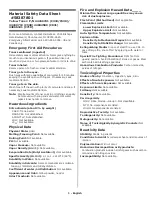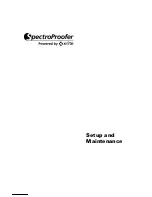
Chapter 4
39
Loading Inks and Materials
P83173A RevA
7/19/10
♦
Maximum rolled material thickness is 0.030
"
(0.76mm).
♦
Minimum rolled material width is 24
"
(61cm).
♦
Minimum sheet size is 12
"
x 12
"
(30.5cm x 30.5cm).
NOTE: It is recommended that Gerber-qualified materials be used to obtain the best results. See
gspinc.com/applications for more information.
CAUTION: The
Gerber CAT|UV does not detect material size (length or width).
Material size must be set in the RIP and the user must be careful to load the correct
size material to accommodate the job.
When printing on roll stock using a printer that is equipped with the roll-to-roll option, there
must be a ½" (13mm) border on either side of the job to accommodate the material hold down
devices. Take this border into consideration when planning your prints. See “Understanding
printing margins” on page 47.
Rigid sign blank material must be flat within 0.03" (0.76mm). Warped material may jam in the
printer. Material that is bowed upward will contact the print carriage.
When printing on rigid substrates you have the option of full bleed printing which allows the
Gerber CAT|UV to print a job larger than the sign blank, resulting in the printed area extending
beyond the edges of the material.
CAUTION: Incorrect arrangement of boards on the table, or adjusting or modifying
the print gap can result in UV light being reflected into the print heads causing
nozzle blockages. These failures are not covered under warranty. In order to ensure
print and printer-favorable conditions are met for each print, adhere to the related
requirements starting on page 45.
NOTE: It is recommended that you use only Gerber-qualified materials for the Gerber
CAT|UV. Printer problems that may occur due to use of materials other than those
recommended by Gerber are not covered by the Gerber CAT|UV warranty. See
gspinc.com/applications for a current list of qualified materials.
Normalizing material
The size of material can change depending on the temperature and/or humidity of the working
environment. For the best print-to-cut registration, “normalize” the material in the working
environment for at least 24 hours before printing.
If the substrate has been stored in a location with temperature and humidity that is far beyond
the recommended range for the Gerber CAT|UV, or for the substrates themselves, be aware
that substrates deep within a stack of material may take longer to normalize than the surface
pieces.
Cleaning the material
Substrate manufacturers provide important information on usage, storage, cleaning, and
disposal, as well as application tips for their materials. Review these documents and follow the
instructions before printing. See gspinc.com/applications and the manufacturer’s website for
the most current information and instructions.
















































